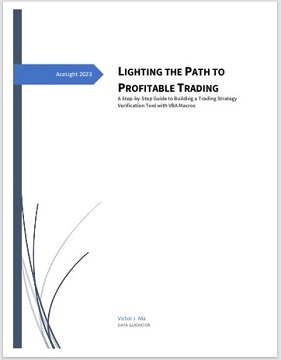10 Hilariously Effective Stock Market Trading Strategies For Beginners
|
|
Welcome, fellow traders! Have you ever felt like you're in a game of musical
chairs while trading stocks? The only difference is that instead of chairs,
you're scrambling for profits, and instead of music, there's the sound of
stock prices rising and falling. But fear not, my friends! In this article,
we'll be exploring some trading strategies to help you stay ahead of the
game.
Stock trading is a popular way for investors to make money by
buying and selling stocks with the goal of capitalizing on price
fluctuations in the market. However, with the ever-changing behavior of the
trading in the stock market, it demands evolving and dynamic strategies. In
this article, we will discuss some of the most effective stock trading
strategies to help you maximize your profits.
1. Value Investing
Strategy:
The value investing strategy involves identifying stocks
that trade for less than their intrinsic value. Investors hold these shares
until the market price rises, taking advantage of low market volatility.
This strategy is based on fundamental criteria that help determine companies
with exceptional quality characteristics. The focus is on buying
high-quality companies that continue to grow profits.
One example of
value investing Strategy is Warren Buffett's investment in Coca-Cola in the
late 1980s. At the time, Coca-Cola's stock price was depressed due to a
series of missteps by the company, causing many investors to sell their
shares. However, Buffett recognized that Coca-Cola had strong brand
recognition, a loyal customer base, and a history of generating consistent
profits. He saw the company as undervalued, and invested heavily in its
stock. Over time, Coca-Cola's stock price rebounded, and Buffett's
investment paid off handsomely.
2. Trend Following Strategy:
According to this strategy, you should purchase stocks at booming prices and
sell when prices start showing a downward trend. Mathematical factors and
calculations are used to determine stock moves and to understand how to
analyze stock market trends better.
A popular example of a trend
following strategy is the Moving Average Crossover strategy. This strategy
involves using two moving averages of different time periods, such as a
50-day moving average and a 200-day moving average. When the shorter-term
moving average crosses above the longer-term moving average, it is
considered a buy signal. Conversely, when the shorter-term moving average
crosses below the longer-term moving average, it is considered a sell
signal. The idea behind this strategy is to follow the trend of the market
and to enter and exit positions based on the direction of the trend.
3. News Trading Strategy:
The news trading strategy involves trading
based on news and market expectations, both before and following news
releases. Trading on news announcements can require a skilled mindset as
news can travel very quickly on digital media. Traders need to assess the
news immediately after it’s released and make a quick judgment on how to
trade it.
An example of the news trading strategy could be a trader
monitoring the news and economic announcements of a particular country. If
the announcement suggests positive news such as increased GDP or low
unemployment rates, the trader might decide to buy the currency of that
country, anticipating a rise in its value. Alternatively, if the news is
negative, the trader might sell the currency in anticipation of a decline in
its value. For instance, a trader could have profited from the Brexit news
in 2016 by selling the British pound in advance of the referendum results,
which resulted in a sharp drop in its value.
4. Candlestick
Pattern Strategy:
Candlestick charts are a technical tool that packs data
for multiple time frames into single price bars. This makes them more useful
than traditional open, high, low, close bars or simple lines that connect
the dots of closing prices. Candlesticks build patterns that may predict
price direction once completed, such as
Three White
Soldiers and Three Black Crows,
Golden Cross and Death Cross,
etc. Proper color coding adds depth to this colorful technical tool, which
dates back to 18th century Japanese rice traders and works well until today.
5. Indicator Strategy:
Stock trading indicators refer to any
analytical tool that can assist you in making informed decisions about your
trades. Essentially, an indicator is any numerical measure at a particular
moment that offers an understanding of the current status of the stock, such
as MACD,
RSI, KDJ, etc. Based
on charts and indicators, there are various strategies. Many traders believe
they can accurately forecast prices.
6. Swing Trading Strategy:
Swing trading refers to trading both sides on the movements of any
financial market. Swing traders aim to ‘buy’ a security when they suspect
that the market will rise. Otherwise, they can ‘sell’ an asset when they
suspect that the price will fall. Swing traders take advantage of the
market’s oscillations as the price swings back and forth, from an overbought
to oversold state.
For example, buying a stock that is experiencing a
short-term dip in price due to a market overreaction, with the intention of
selling it once the stock has rebounded and the price has increased. The
trader might look for stocks with strong fundamentals that have experienced
a temporary setback, and set stop-loss orders to limit potential losses. The
trader may hold the position for a few days to a few weeks, depending on
market conditions and the price movement of the stock. The goal is to
capture gains from short-term fluctuations in the market while minimizing
risk.
7. Day Trading Strategy:
Day trading or intraday trading
is suitable for traders that would like to actively trade in the daytime,
generally as a full-time profession. Day traders take advantage of price
fluctuations between the market open and close hours. Day traders often hold
multiple positions open in a day but do not leave positions open overnight
to minimize the risk of overnight market volatility.
Here is an
example of a day trading strategy: Suppose a day trader who focuses on
trading stocks notices that a certain stock tends to experience significant
price movements during the first hour of the trading day. The trader decides
to use a strategy that takes advantage of these early price movements by
buying or selling the stock within the first 30 minutes of the trading day.
The trader sets up their chart with several technical indicators such as
moving averages, Bollinger Bands, and Relative Strength Index (RSI), and
watches the stock's price closely. When the price moves above or below a
certain level, the trader enters a position in the direction of the trend
and sets a stop-loss order to limit their risk.
Once the trader is in
a position, they monitor the stock's price closely, and if it moves in their
favor, they may take profits or adjust their stop-loss to lock in gains. If
the price moves against them, they will exit the trade quickly to limit
their losses.
The trader may repeat this process several times throughout
the trading day, taking advantage of short-term price movements and trying
to achieve a profit by the end of the day.
8. Scalping Trading
Strategy:
Traders who use a scalping strategy place very short-term
trades with small price movements. Scalpers aim to ‘scalp’ a small profit
from each trade in the hope that all the small profits accumulate. As a
scalper, you must have a disciplined exit strategy as a large loss can
eliminate many other profits that have accumulated slowly and steadily.
For instance, a trader who focuses on small price movements in a highly
liquid market, such as the Forex market. The trader may use a combination of
technical indicators and chart patterns to identify short-term price trends
and make frequent trades with a small profit target of a few pips. The
trader may use high leverage and execute trades quickly, aiming to take
advantage of small price movements and make multiple small profits
throughout the trading day. This strategy requires discipline and quick
decision-making skills, as well as a thorough understanding of market
dynamics and risk management techniques.
9. Gap Strategy:
Gaps
in stock prices occur due to various fundamental or technical factors. For
example, when a company's earnings exceed expectations, its stock price may
gap up the next day. Some traders take advantage of these gaps by buying or
selling based on technical or fundamental factors, anticipating that the gap
will eventually be filled, meaning that the price will move back to its
original pre-gap level.
An example of a Gap Strategy could be a
trader who closely monitors a particular stock and its market events, such
as earnings reports or industry news. If the trader anticipates that the
stock will gap up the next day based on these events, they may place a buy
order after the market closes, hoping to take advantage of the potential
price increase at market open. Alternatively, if the trader anticipates a
gap down, they may place a sell order after hours to sell the stock short,
hoping to profit from the potential price decline. The trader would then
monitor the stock's movement at market open and adjust their position
accordingly.
10. Short Selling Strategy:
Lastly, short selling
strategy is a technique that involves selling securities that are borrowed
by the seller for making short sales. This strategy helps to produce profits
when the stock market is declining. This strategy can be risky, and it
requires a thorough understanding of the stock market and its movements.
For instance, if an investor believes that a company's stock is
overvalued and likely to decline in the near future, they may borrow shares
from a broker and sell them in the market. If the stock price indeed drops
as anticipated, the investor can buy the shares back at a lower price and
return them to the broker, making a profit on the difference between the
sale price and the buyback price. As an example, let's say an investor
borrows 100 shares of XYZ Company at a price of $50 per share and sells them
for a total of $5,000. If the stock price later drops to $40 per share, the
investor can buy 100 shares for $4,000 and return them to the broker,
pocketing a profit of $1,000 (minus any fees and interest charges associated
with the borrowing).
 Remember, as with all things in life, there are no
guarantees. These ten hilariously effective stock market trading strategies
for beginners are simply a starting point. For any trading strategy, no
matter how good it sounds, we must test it before using it in the real
market. These tests include back-testing and forward-testing. Without proper
testing, trading will turn into guesswork or even worse, gambling. So, go
forth and conquer the stock market, or as they say, "Buy low, sell high, and
pray for a little luck!" Good luck and happy trading! Remember, as with all things in life, there are no
guarantees. These ten hilariously effective stock market trading strategies
for beginners are simply a starting point. For any trading strategy, no
matter how good it sounds, we must test it before using it in the real
market. These tests include back-testing and forward-testing. Without proper
testing, trading will turn into guesswork or even worse, gambling. So, go
forth and conquer the stock market, or as they say, "Buy low, sell high, and
pray for a little luck!" Good luck and happy trading!
Click
LIGHTING THE PATH TO PROFITABLE TRADING: A Step-by-Step Guide to Building a Trading Strategy Verification Tool with VBA Macros to get the whole tutorial handbook for free!
And click Free Trial to download strategies testing tools, all for a 30-day Free Trial.
Click on Subscription to order more strategies testing tools to help your stock trading.
|


|

Free Tutorial
Share
|
|
|
|